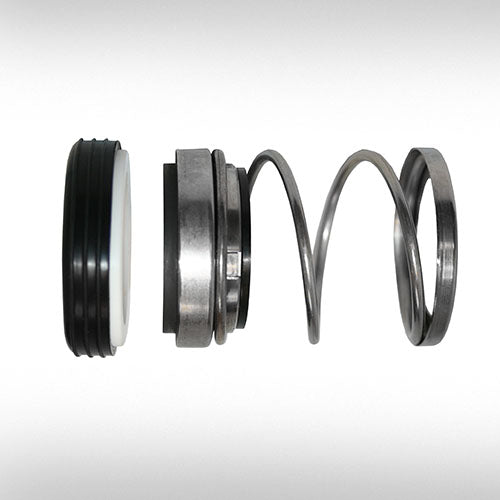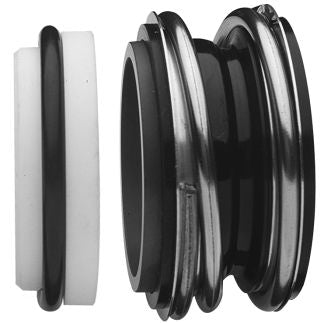
Rubber Diaphragm Mechanical Seals

Robust, hard wearing, reliable and highly accommodating
Rubber diaphragm mechanical seals provide enhanced seal capability, performance and life. That is why they are one of the most widely used mechancial seal types.
How do rubber diaphragm seals work?
Rubber diaphragm seals operate by using a flexible rubber diaphragm that provides a robust static seal around the shaft. The seal is achieved by squeezing the rubber diaphragm onto the shaft with a drive ring. Once in place, the rubber diaphragm grips the shaft firmly, creating a strong static seal and ensuring a positive drive to the seal face via the drive ring. There is no relative movement between the shaft and the rubber diaphragm, which eliminates shaft fretting, wear, and hang-up hysteresis. This design allows the seal to accommodate some shaft run-out and misalignment immediately.
The elastomer rubber flexes at its junction point to handle shaft axial movement and other movements required during the seal's working life. The seal head adjusts automatically to compensate for face misalignment, usually caused by shaft end float or pump body misalignment. The closing spring force and the seal pumping pressure force maintain the seal faces in full contact, while the rubber diaphragm acts like an elastomeric bellows, providing sustained flexibility. The positive drive of the seal face is transmitted via the drive ring and retaining housing, rather than the spring, which only provides some closing force to the mechanical seal faces. This design allows the seals to be used for shafts rotating in either direction and in vacuum applications.
What Are Rubber Diaphragm Seals Used For?
Rubber diaphragm seals are used in various applications where a reliable seal is necessary to prevent leakage around rotating shafts. They are particularly useful in pumps, compressors, and mixers where there is a need to handle axial movement, misalignment, and shaft run-out. These seals are suitable for both vacuum applications and environments where the shaft may rotate in either direction. Their ability to accommodate misalignment and maintain flexibility makes them ideal for use in industries such as chemical processing, water treatment, and food and beverage manufacturing.
What Are the Main Types of Rubber Diaphragm Seals?
The main types of rubber diaphragm seals include:
- Standard Rubber Diaphragm Seals: These seals use a rubber diaphragm to provide a strong static seal and accommodate shaft misalignment and axial movement. They are commonly used in general industrial applications.
- High-Performance Rubber Diaphragm Seals: These seals are designed for more demanding applications, offering enhanced resistance to chemicals, higher temperatures, and greater mechanical stress.
Both types are designed to provide reliable sealing solutions for rotating shafts, with the ability to handle various operational challenges.
What Are the Benefits of Rubber Diaphragm Seals?
Rubber diaphragm seals offer several key benefits:
- Elimination of Shaft Fretting and Wear: With no relative movement between the shaft and the rubber diaphragm, these seals prevent shaft fretting and wear, extending the lifespan of the equipment.
- Accommodation of Misalignment and Axial Movement: The flexible rubber diaphragm can handle shaft misalignment and axial movement, ensuring a reliable seal even under varying operational conditions.
- Sustained Flexibility: The elastomeric properties of the rubber diaphragm provide sustained flexibility, allowing the seal to maintain its effectiveness over time.
- Positive Drive Transmission: The drive ring and retaining housing transmit the positive drive of the seal face, ensuring a secure and reliable seal without relying on the spring force alone.
- Versatility: These seals can be used for shafts rotating in either direction and are suitable for vacuum applications, offering versatility across various industrial settings.
Rubber diaphragm seals are highly effective and versatile solutions for sealing rotating shafts. Their ability to eliminate shaft wear, accommodate misalignment, and maintain flexibility makes them ideal for a wide range of applications, ensuring reliable performance and extended equipment life.
Examples of rubber diaphragm mechanical seals
Once fitted, the rubber diaphragm will grip the shaft giving a strong static seal and very positive drive, via the drive ring, to the seal face.
Order before 2pm to get same day dispatch next day delivery
Need help with a rubber diaphragm mechanical seal?
Our expert team are on hand to help you.
Our Mechanical Seals range
Check out our extenisve mechanical seal range, including replacement seals for most major manufacturers: Eagle Burgmann, John Crane, Roten/Uniten, AES, Alfa Laval, Grundfos, MTU, PAC-Seal, US Seal and more.
Our most popular mechanical seals
-
Burgmann MG12 Equivilant Mechanical Seal
Regular price From £117.19 GBPRegular priceUnit price / per -
Roten Type 2 Equivalent Mechanical Seal
Regular price From £117.19 GBPRegular priceUnit price / per -
Burgmann MG1 Equivilent Mechanical Seal
Regular price From £117.19 GBPRegular priceUnit price / per -
Burgmann MG13 Equivilant Mechanical Seal
Regular price From £117.19 GBPRegular priceUnit price / per
Looking for the perfect seal?
-
Identify the seal you need
Use toolIndentify the seal you need using our Mechanical Seal Idenitifcation tool by selecting the key design features.
-
Know your material
View guideFind out the ideal seal material for your requirement using our Mechanical Seals Materials Guide.
-
Check Chemical Compatibility
Check materialsUse our compatibility checker to ensure you are using the most effective material for your seal.







